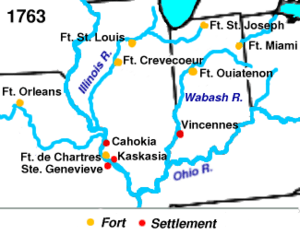History of St. Louis before 1762 facts for kids
The history of St. Louis, Missouri began long before Europeans arrived. It was shaped by ancient Native American groups, early European explorers, and French trading posts built along the Mississippi River.
Early Settlements and Mound Builders
The first settlements in the St. Louis area were built by people of the Mississippian culture. These groups are often called the "Mound Builders." They created more than two dozen large mounds in what is now St. Louis. The oldest mounds here date back to about 1050. We don't know everything about these ancient people.
Most of the mounds in St. Louis were later destroyed. Only one mound, called Sugarloaf Mound, still stands in the city. But St. Louis was known as "The Mound City" for a long time.
The Mississippi River and its smaller rivers, like the Missouri River, were very important. Native Americans used the big forests along the rivers to build canoes. These canoes helped them travel and trade. After the Mississippian culture ended around the 1300s, other Native American groups moved into the area. These included the Missouri and Osage tribes. They lived in villages along the Osage and Missouri rivers. These groups sometimes fought with other tribes like the Sauk and Fox. All these tribes met the first European explorers in Missouri.
European Explorers Discover the Mississippi Valley
Europeans started exploring this area almost 100 years before St. Louis was founded. In the early 1670s, a French official named Jean Talon wanted to explore the Mississippi River. He heard rumors that it might lead to the Pacific Ocean.
In June 1673, explorer Louis Jolliet and a priest named Jacques Marquette reached the Mississippi River. They traveled past where the Missouri and Mississippi rivers meet. They went as far as the Arkansas River. Joliet then turned back north. He realized the river didn't go to the Pacific. He also worried about attacks from Spanish settlers.
Nine years later, another French explorer, La Salle, led an expedition. He traveled south from the Illinois River to the mouth of the Mississippi. He claimed the entire river valley for France. La Salle named this huge area Louisiana, after King Louis XIV. The land between the Ohio and Mississippi rivers was called Illinois Country.
The French built forts and settlements in the Mississippi valley. In 1699, they built a settlement on the east bank of the Mississippi at Cahokia, Illinois. This was near the famous Cahokia Mounds. The next year, the Kaskaskia tribe built a village in the St. Louis area. Two Jesuit priests, Pierre-Gabriel Marest and Francois Pinet, built a small mission there. They named the river the River des Peres (River of the Fathers). But by 1703, the Kaskaskia moved to the east bank. They built a new settlement called Kaskaskia, Illinois.
French Settlements and the Seven Years' War
France wanted to develop the Mississippi valley more. In 1712, a man named Antoine Crozat was given a special right to trade there. He hoped to find gold and silver. But his plan failed by 1717.
Then, a Scottish banker named John Law got a new trade deal. In 1717, he convinced King Louis XIV to give his company, the Company of the West, a 25-year trade monopoly. This meant they were the only ones allowed to trade and own mines in the region. The company promised to bring many settlers and build churches.
The company founded New Orleans as the capital of Louisiana in 1718. Even after some financial problems, the company helped build the capital of the Illinois Country. This was at Fort de Chartres, north of Kaskaskia. Another early settlement near St. Louis was Ste. Genevieve, Missouri. It was built in 1732. It was a good port for salt and ore mined on the western side of the Mississippi.
The French started trading with tribes along the Missouri River in the 1720s and 1730s. They also focused on trading with the Spanish colony of New Mexico. Several trade trips happened between New Mexico and the Mississippi valley.
However, the Seven Years' War (1756–1763) changed things. This war greatly hurt many French traders. After the war, the French governor of Louisiana started giving out trade monopolies in different areas. This was to help the economy grow again.


